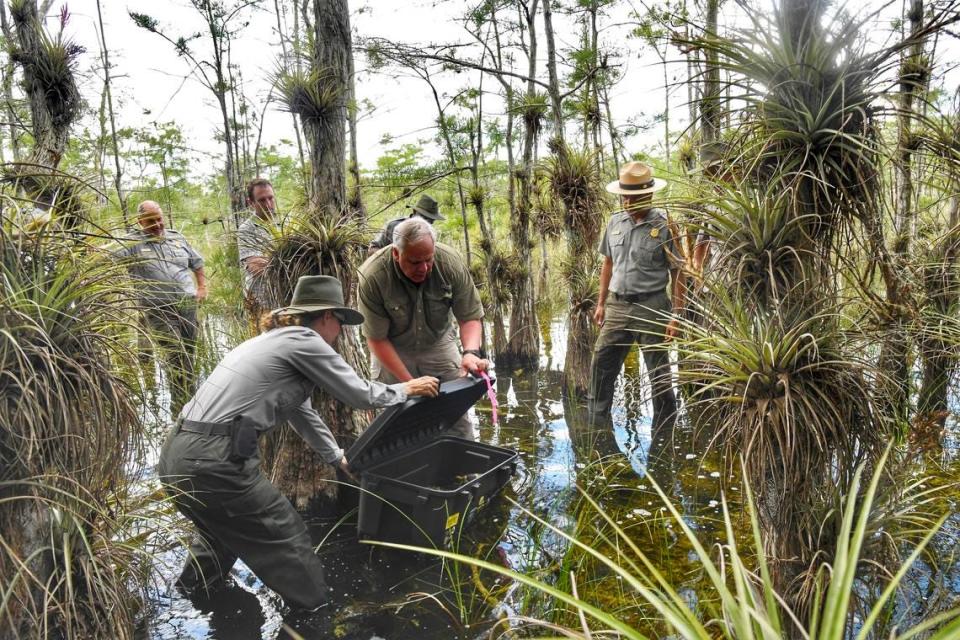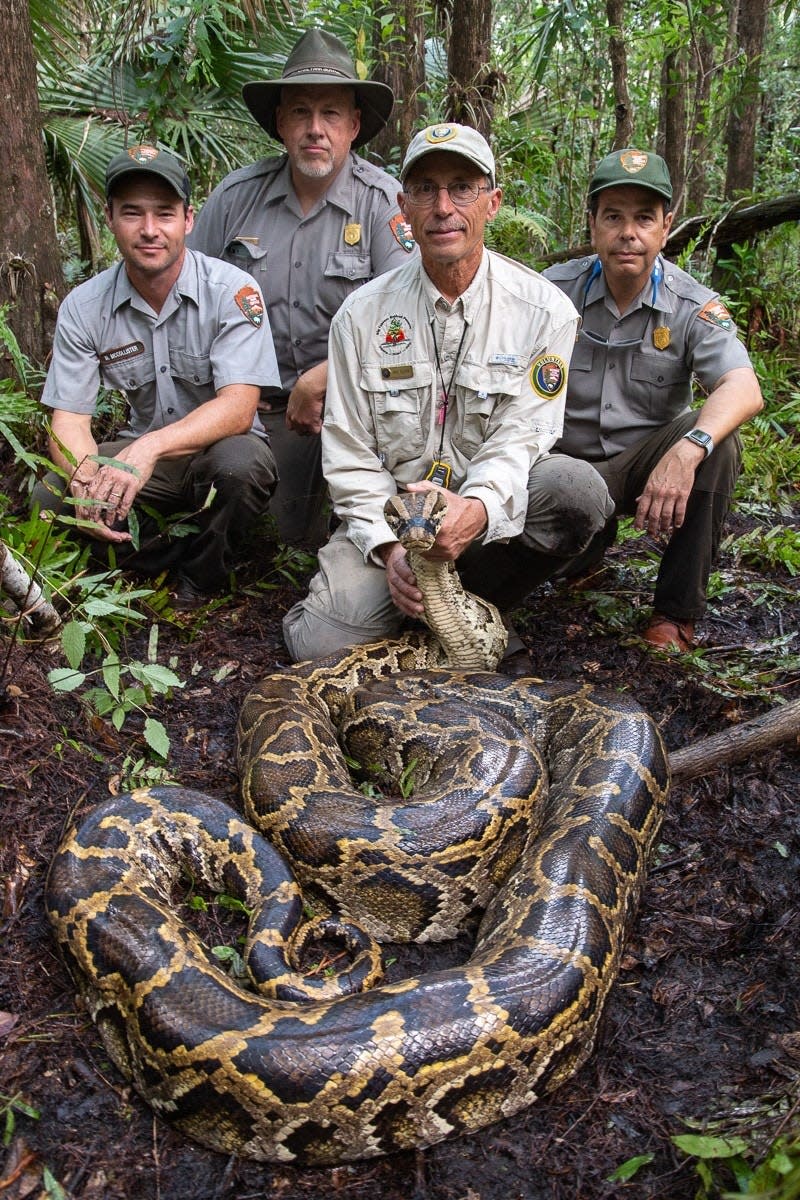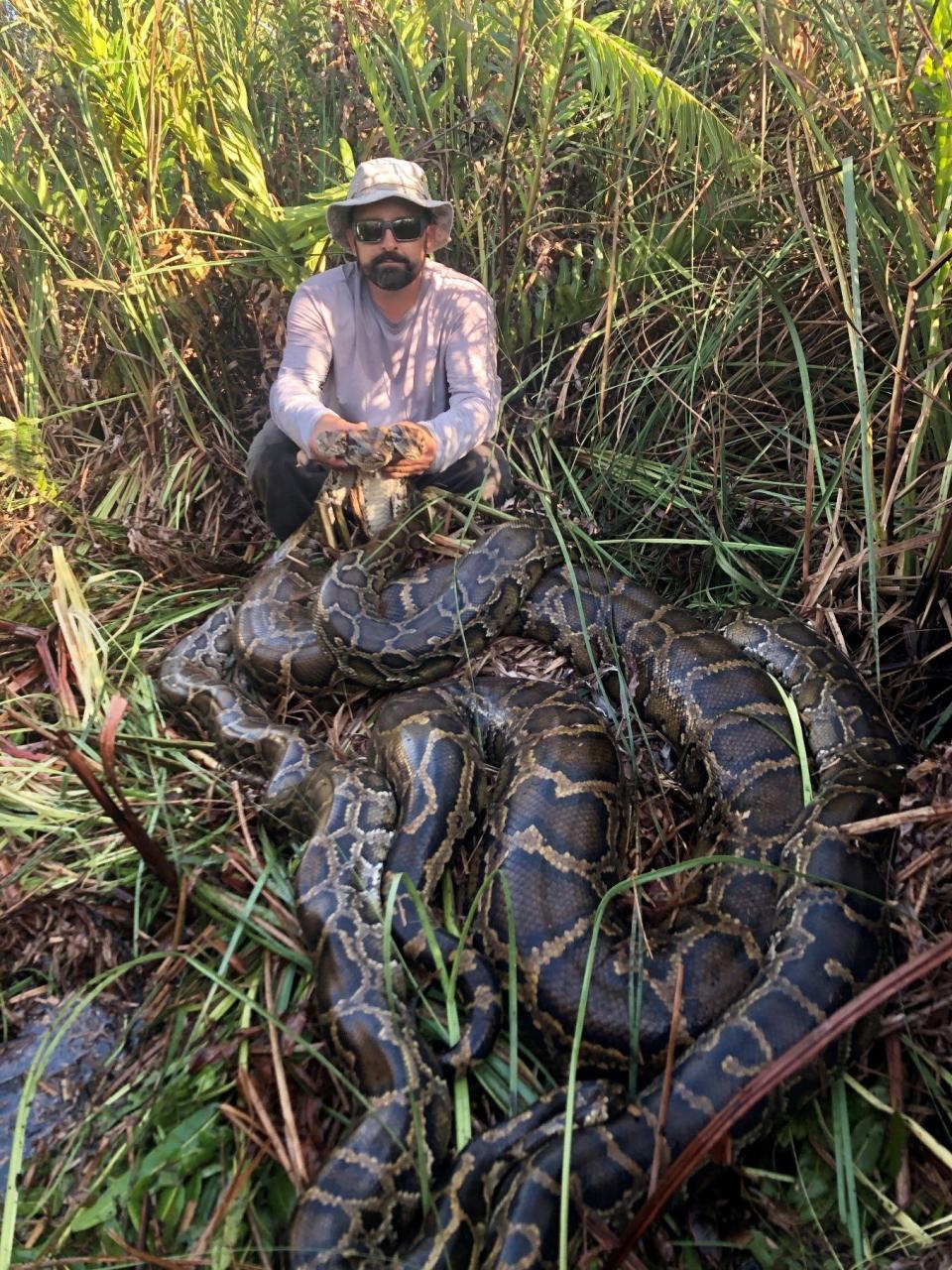A Florida python named Elvis is helping stop the spread of the state's most notorious pest
STUART, Fla. – The war being waged against Florida's most notorious pest experienced a recent battlefield victory. It's a sign humans could finally be gaining ground against one of the greatest invasions ever to occur on American soil: the spread of Burmese pythons.
No one is celebrating yet. But this past winter, the good guys took a big step in pushing back the battle lines against one of the world's most voracious predators.
Python breeding season typically runs November through March. Its peak is right around Valentine's Day, of course.
Partners in South Florida's radio signal python tracking program combined this past season to remove:
86 adult pythons
5,000 pounds approximate combined weight
53 reproductive females
2,500 developing eggs
That's 2,500 fewer Burmese pythons that one day would wreak havoc on Florida's native mammals, birds and other reptiles.
Scout snakes
The collective harvest marked the most successful season yet since 2006, when scout snake tracking programs first came into use..
More: Python hunter alone in Florida Everglades suffers bloody bite, brings home 17-foot snake
The teamwork of the U.S Geological Survey, the National Park Service, U.S. Fish and Wildlife Service and Conservancy of Southwest Florida has enabled research-based removal of pythons to become more effective.
“Our experts are committed to using innovative methods and technologies to track invasive pythons,” said U.S. Secretary of the Interior David L. Bernhardt. “This partnership will further aid in our efforts to eliminate this growing threat to South Florida’s ecosystem and biodiversity.”
The tracking program is part of the Interior Department's $142 million commitment in fiscal year 2020 to invasive species management activities including prevention, early detection, rapid response, control and research.

How the scout snake program works:
Male snakes are captured as they move across roads, paths, trails and along levees, or when they are found in breeding aggregations.
They are transported to one of several locations for surgery.
Veterinarians implant a radio transmitter about the size of a AA battery.
Snakes are then released back into areas near where they were collected.
Snakes are tracked using their radio signal.
Biologists find the male snakes breeding with or nearby female snakes.
Females and some other males are humanely euthanized and data is collected.
Other males found in breeding groups are sometimes drafted into the tracking program.
Scout snakes are marked on the outside of their bodies with fluorescent orange tags and highly visible scale marks. Anyone who finds one of these should take a photo, leave the snake where it was found and report its location to the email address on the tag.
The 'Most Valuable Pythons' – led by Elvis
The Conservancy of Southwest Florida has operated its radio tracking program since 2013. Conservancy python environmental science project manager Ian Bartoszek said his program currently uses 40 tagged male pythons in its platoon of python scouts. But a few of the snakes have become war heroes.
"I call a few of these snakes my MVPs – Most Valuable Pythons," Bartoszek said. "They're led by Elvis, The King, who was tagged in 2013 and reigns as the world's longest surviving tagged male python."
Joining Elvis on Baroszek's MVP patrol are Johnny "He's My Boy," Luther, Ender and Quattro. Together the MVPs rooted out 10 females this past season. Elvis and Quattro each located three. Luther and Johnny, two each, including two 100-plus pounders found by Johnny.

Flattening the curve
What may be more notable, Bartoszek said, is Ender's inability to locate a breeding group.
"Ender is the one we're most excited about because the previous seasons he was usually good for two large females," Bartoszek explained in a text. "Since he didn't find any this year, it means we likely cleaned up that sector."
In a sense, the program is "flattening his curve," for breeding female pythons.
The Conservancy of Southwest Florida has demonstrated the potential efficacy of tracking programs. Throughout its roughly 60-square-mile range, the program has removed 15,500 pounds of pythons.

'I hoped we could get 2,000 pounds of snakes'
Matthew McCollister, a biologist with the National Park Service based at Big Cypress, Florida, set a goal for captures heading into this, the park service's third breeding season working with scout snakes.
"We entered the season with 22 tagged males and I had told another biologist I hoped we could get 2,000 pounds of snakes out of Big Cypress," McCollister said. "We lost a few of the scouts during the season, but we ended up with 2,100 pounds of snakes removed, located by 13 male snakes."
That was triple the production from the previous year, McCollister said. The program went from locating six breeding events in 2018-19 to finding 20 this year. One event resulted in the removal of a 125-pound female, a 90-pound male – the largest one found by the program – and a 25-pound male, or 240 pounds of snakes.
Big terrain
One problem facing this python removal program is the terrain. Big Cypress is 729,000 acres across parts of Collier, Monroe and Miami-Dade counties, making it larger than Rhode Island. Finding a snake there is literally like finding a needle in a haystack in a field of haystacks.
Park service and USGS teams working together can locate the males, but often they are deep in palmetto stands, cypress swamps or, in some cases McCollister explained, underground buried in thick peat or limestone tunnels.
Even after finding a breeding gathering of snakes, packing out 200 pounds of pythons is no simple task. It involves several people throwing a snake as thick as a man's thigh across their shoulders and traipsing more than a mile through 2 feet of swamp water, through pine flatwoods covered in palmetto thickets, or through a no-see-um and mosquito-infested red mangrove salt marsh.
McCollister said he has resorted in some cases to performing field necropsies to collect needed biological data after humanely euthanizing the snakes.

'Adult deer hooves' found in snakes' stomachs
"One thing that was alarming was in two snakes' stomach contents, I found adult deer hooves," McCollister said. "And our deer field surveys on the south side of U.S. 41 indicate a severely waning population."
To a python, Florida's rich biodiversity of mammals, birds, reptiles and amphibians is a veritable smorgasbord of delicacies. According to the USGS, a 2012 study in Everglades National Park revealed pythons have contributed to these population declines:
99.3% fewer raccoons.
98.9% fewer opossums.
87.5% fewer bobcats.
Foxes and marsh and cottontail rabbits have "effectively disappeared," the study says.
Pythons are also eating birds, native snakes and alligators. The food they remove from the landscape also is denied Florida's native predators such as panthers, bobcats, foxes, snakes and alligators.
The pythons could very well be running out of food. But Bartoszek said the tracking program in his area may be having an impact.
"We're seeing different behavior in the snakes we're tracking," he said. "We're seeing them move farther distances to more remote areas to breed. We've even found some breeding on mangrove islands. In key sectors of our removal zone, the snakes are having a harder time finding mates and having to range farther to do so."
Using the snakes' behavior against themselves appears to be making a slight difference, he said. It does not mean other python removal programs, such as the hunters working for the South Florida Water Management District and Florida Fish and Wildlife Conservation Commission, should not continue full speed ahead.
"Our scouts have infiltrated the snake population and we're winning some key battles," Bartoszek said.
Burmese python facts
Maximum length: 26 feet.
Maximum weight: 200 pounds.
Average length of those removed: 8-10 feet.
Native range: India to lower China, throughout the Malay Peninsula and on some East Indies islands.
Habitat: Typically lives near water.
Average clutch: 50-100 eggs.
Source: Florida Fish and Wildlife Conservation Commission
Follow Ed Killer on Twitter:@tcpalmekiller.
This article originally appeared on Treasure Coast Newspapers: South Florida's radio signal python tracking program nabs 86 snakes

